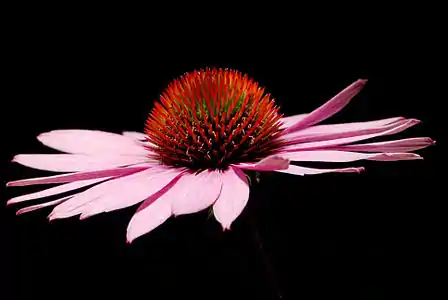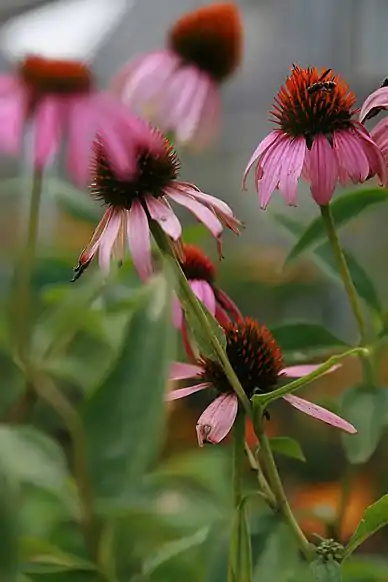Echinacea angustifolia
Echinacea angustifolia, the narrow-leaved purple coneflower or blacksamson echinacea,[2] is a species of flowering plant in the sunflower family. It is native to North America, where it is widespread across much of the Great Plains of central Canada and the central United States, with additional populations in surrounding regions.[3]
| Echinacea angustifolia | |
|---|---|
_2016-07-12_963.jpg.webp) | |
| Scientific classification | |
| Kingdom: | Plantae |
| Clade: | Tracheophytes |
| Clade: | Angiosperms |
| Clade: | Eudicots |
| Clade: | Asterids |
| Order: | Asterales |
| Family: | Asteraceae |
| Genus: | Echinacea |
| Species: | E. angustifolia |
| Binomial name | |
| Echinacea angustifolia | |
| Synonyms[1] | |
|
Brauneria angustifolia (DC.) A.Heller | |
E. angustifolia is a perennial herb with spindle-shaped taproots that are often branched. The stems and leaves are moderately to densely hairy. The plant produces one flower heads one branch - each at the end of a long peduncle. Each flower head contains 8–21 pink or purple ray florets plus 80–250 orange disc florets.[2]
Echinacea angustifolia blooms in late spring to mid-summer. It is found growing in dry prairies and barrens with rocky to sandy-clay soils.[2] There are two subspecies:[4][5]
- Echinacea angustifolia subsp. angustifolia is native to central Canada and the central United States from Saskatchewan and Manitoba in the north to Arizona, New Mexico, Texas, and Louisiana in the south.
- Echinacea angustifolia subsp. strigosa has a more limited range in Kansas, Oklahoma, Texas, and Louisiana.[6]
Many Native American groups used this plant for a variety of medicinal purposes, including pain relief and relief of colds and toothaches.[7] A weak antibiotic substance, the main root metabolite echinacoside (q.v.), is a marker constituent for E. angustifolia and E. pallida.
Morphology
The word "Echinacea" is derived from the Greek word "echinos" which means sea urchin or hedgehog; a feature that can be observed in the flower head of the plant.[8]
Echinacea angustifolia is about 10-50 cm in length.
The plant consists of white to pink or deep purple flower petals that characteristically wilt downwards, while the ray florets of the flower head range from green to red-brown in color.[9] The leaves are dark green and can be oblong-lanceolate or elliptical in shape.[10] The plant has pubescent stems with rhizomes present underground.

https://commons.wikimedia.org/wiki/File:Echinacea_angustifolia_-_01Aug2009_-_01.jpg
Reproduction, Life Cycle, and Other Features
The plant does not self pollinate and requires assistance from bee pollinators in the reproduction process.[11] In Echinacea angustifolia there is greater success in pollination between mates that are at a closer proximity between one another. Echinacea angustifolia is an herbaceous perennial plant, producing flowers and living more than two years at a time.[12] The plant is known to grow at a slow rate and is drought-resistant to help the plant survive in its temperate grassland habitat.[13]

Medicinal Properties
Echinacea angustifolia has a number of unique medicinal properties that have been proven to assist in helping the immune system, decrease blood sugar level, and prevent the proliferation of cancerous cells.
The hydroalcoholic root extract of the plant is rich in phenols and flavonoids, two components that have been shown to increase antioxidant activity in organisms.[14] The connection between phenols and flavonoids and antioxidant activity was confirmed in Echinacea angustifolia in a recent study that showed a greater level of protection against the harming effects of free radicals.[15] Echinacea angustifolia root extract also has a higher number of alkylamides than the subspecies Echinacea purpurea.[16] Alkylamides have immunomodulatory effects that support the suppression and the activation of the immune system.[17] Another important medicinal property found in the hydroalcoholic root extract of Echinacea angustifolia is the ability to lower blood sugar levels, also known as hypoglycemic effects. This plant also has anti-proliferation effects, specifically in pancreatic cancer cells, where cell division is inhibited.[18]
Greater root density is observed in Echinacea angustifolia growing in higher latitude, in turn, producing a greater quantity of phenols and alkylamides available in the root extract.[19]
References
- The Plant List, Echinacea angustifolia DC.
- Flora of North America, Narrow-leaved purple coneflower, blacksamson echinacea, Echinacea angustifolia de Candolle in A. P. de Candolle and A. L. P. P. de Candolle, Prodr. 5: 554. 1836.
- Biota of North America Program 2014 county distribution map
- McGregor, Ronald Leighton 1968. Transactions of the Kansas Academy of Science 70(3): 368–369
- Tropicos, Echinacea angustifolia var. strigosa McGregor
- Echinacea angustifolia, United States Department of Agriculture PLANTS Profile
- Echinacea angustifolia. United States Department of Agriculture NRCS Plant Guide.
- Vaverkova, Stefania, Mistríková, Ingrid, and Vaverková, Štefánia. "Morphology and Anatomy of Echinacea Purpurea, E. Angustifolia, E. Pallida and Parthenium Integrifolium." Biologia 62.1 (2007): 2-5. Web.
- Vaverkova, Stefania, Mistríková, Ingrid, and Vaverková, Štefánia. "Morphology and Anatomy of Echinacea Purpurea, E. Angustifolia, E. Pallida and Parthenium Integrifolium." Biologia 62.1 (2007): 2-5. Web.
- Vaverkova, Stefania, Mistríková, Ingrid, and Vaverková, Štefánia. "Morphology and Anatomy of Echinacea Purpurea, E. Angustifolia, E. Pallida and Parthenium Integrifolium." Biologia 62.1 (2007): 2-5. Web.
- Ison, J.L., Wagenius, S., Reitz, D. and Ashley, M.V. (2014), Mating between Echinacea angustifolia (Asteraceae) individuals increases with their flowering synchrony and spatial proximity. American Journal of Botany, 101: 180-189. https://doi-org.lib-proxy.fullerton.edu/10.3732/ajb.1300065
- Ison, J.L., Wagenius, S., Reitz, D. and Ashley, M.V. (2014), Mating between Echinacea angustifolia (Asteraceae) individuals increases with their flowering synchrony and spatial proximity. American Journal of Botany, 101: 180-189. https://doi-org.lib-proxy.fullerton.edu/10.3732/ajb.1300065
- Vaverkova, Stefania, Mistríková, Ingrid, and Vaverková, Štefánia. "Morphology and Anatomy of Echinacea Purpurea, E. Angustifolia, E. Pallida and Parthenium Integrifolium." Biologia 62.1 (2007): 2-5. Web.
- Kumar AS, Mazumder A, Vanitha J, Sivakumar T. 2008. Evaluation of antioxidant activity, phenol and flavonoid contents of some selected Indian medicinal plants. Pharmacogn Mag. 4:143–147. [Google Scholar]
- Aarland RC, Bañuelos-Hernández AE, Fragoso-Serrano M, Sierra-Palacios ED, Díaz de León-Sánchez F, Pérez-Flores LJ, Rivera-Cabrera F, Mendoza-Espinoza JA. Studies on phytochemical, antioxidant, anti-inflammatory, hypoglycaemic and antiproliferative activities of Echinacea purpurea and Echinacea angustifolia extracts. Pharm Biol. 2017 Dec;55(1):649-656. doi: 10.1080/13880209.2016.1265989. PMID: 27951745; PMCID: PMC6130640.
- Mudge E, Lopes-Lutz D, Brown P, Schieber A. Analysis of alkylamides in Echinacea plant materials and dietary supplements by ultrafast liquid chromatography with diode array and mass spectrometric detection. J Agric Food Chem. 2011 Aug 10;59(15):8086-94. doi: 10.1021/jf201158k. Epub 2011 Jul 7. PMID: 21702479.
- Aarland RC, Bañuelos-Hernández AE, Fragoso-Serrano M, Sierra-Palacios ED, Díaz de León-Sánchez F, Pérez-Flores LJ, Rivera-Cabrera F, Mendoza-Espinoza JA. Studies on phytochemical, antioxidant, anti-inflammatory, hypoglycaemic and antiproliferative activities of Echinacea purpurea and Echinacea angustifolia extracts. Pharm Biol. 2017 Dec;55(1):649-656. doi: 10.1080/13880209.2016.1265989. PMID: 27951745; PMCID: PMC6130640.
- Chicca A, Adinolfi B, Martinotti E, Fogli S, Breschi MC, Pellati F, Benvenuti S, Nieri P. Cytotoxic effects of Echinacea root hexanic extracts on human cancer cell lines. J Ethnopharmacol. 2007 Mar 1;110(1):148-53. doi: 10.1016/j.jep.2006.09.013. Epub 2006 Sep 23. PMID: 17052874.
- Aiello, Nicola et al. “Evaluation of the Farming Potential of Echinacea Angustifolia DC. Accessions Grown in Italy by Root-Marker Compound Content and Morphological Trait Analyses.” Plants (Basel, Switzerland) vol. 9,7 873. 9 Jul. 2020, doi:10.3390/plants9070873
| Wikimedia Commons has media related to Echinacea angustifolia. |
